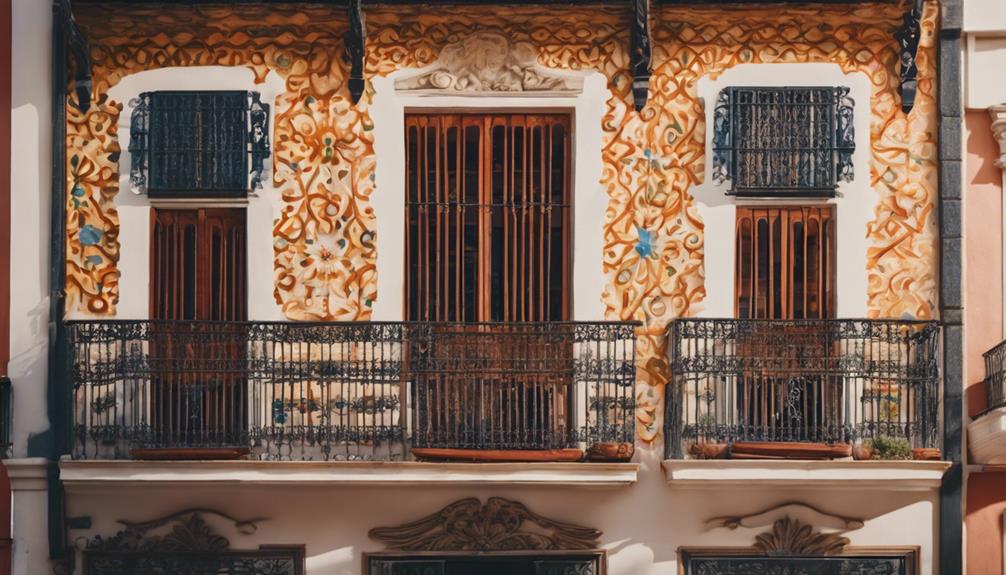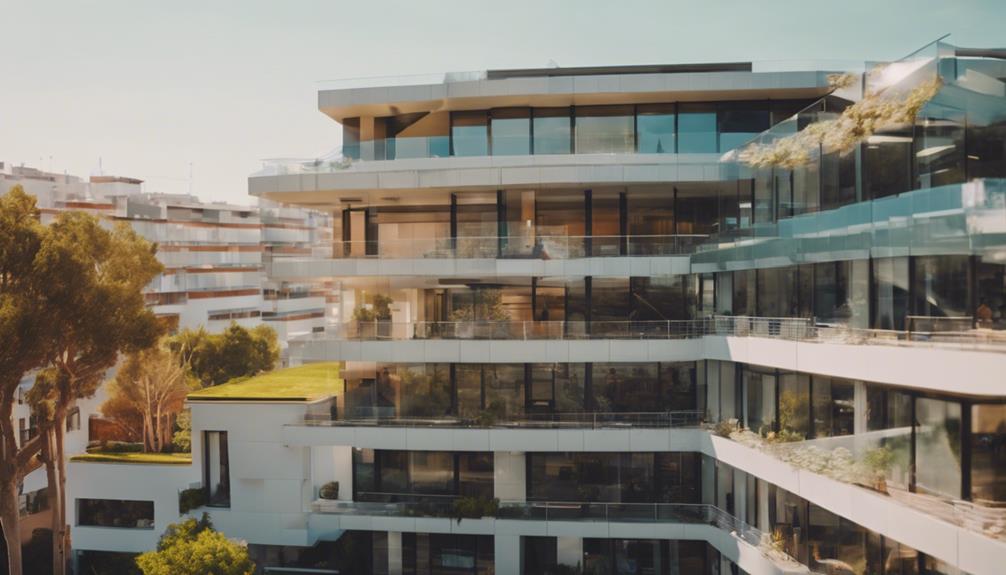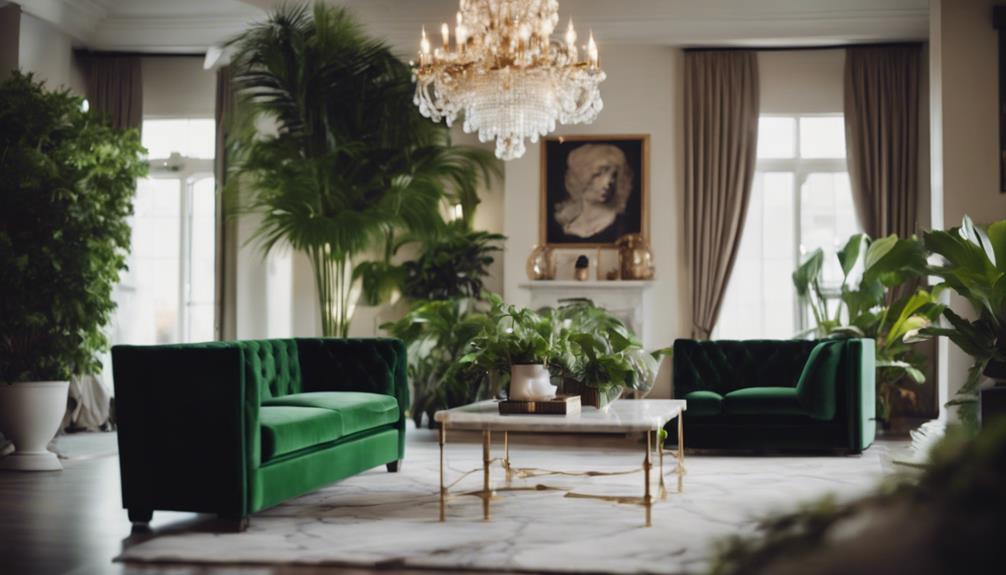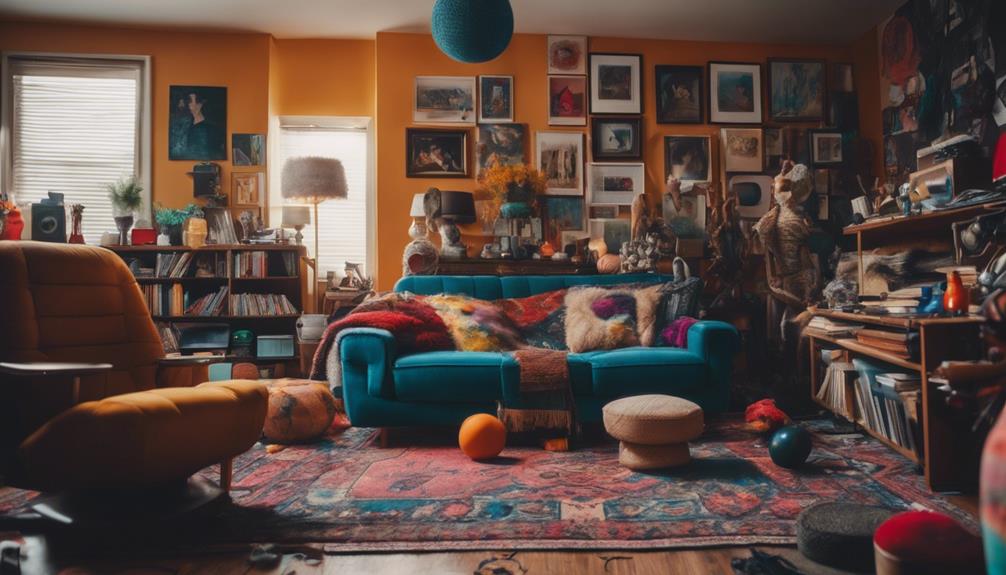Step into the sizzling universe of Spanish architecture, where tradition meets innovation in a scorching blend of design secrets. Discover the magic of shading elements like awnings and shutters that keep buildings cool under the fiery sun. Explore the world of heat-resistant materials and natural cooling techniques that make Spanish architecture a marvel. The architectural fusion and harmony create a unique experience that's sure to captivate your senses and leave you in awe of the brilliance behind these architectural wonders. Want to uncover more about the Spanish architectural masterpiece that defies the need for siestas?
Key Takeaways
- Spanish architectural innovation integrates shading elements for cooling.
- Traditional techniques like courtyards and thick walls combat intense heat.
- Use of heat-resistant materials and natural cooling methods in design.
- Fusion of past and present architectural styles for climate management.
- Modern Spanish architecture balances aesthetics, functionality, and climate control.
Spanish Architectural Innovation
With a history of visionary architects, Spain has consistently pushed the boundaries of architectural innovation. From the UNESCO World Heritage site of Antoni Gaudí's Sagrada Familia in Barcelona to the modernist marvels of Park Güell and Casa Batlló, Spanish architectural creativity shines through. Spanish architects have a unique ability to blend traditional styles with modern influences, resulting in a vibrant architectural landscape that captivates visitors from around the world.
One can't help but marvel at the City of Arts and Sciences in Valencia, a striking example of contemporary Spanish architecture that showcases the country's forward-thinking design principles. The rich history of Spain's architectural heritage reflects a blend of diverse influences and artistic expressions, making each structure a masterpiece in its own right.
In Spain, architectural innovation isn't just about buildings; it's a way of life. Whether you're exploring historic landmarks or taking a siesta under the shade of a beautifully designed structure, the Spanish passion for design is evident everywhere you look.
Shading Elements in Spanish Buildings

Spanish buildings ingeniously incorporate shading elements like awnings, balconies, and shutters to combat the intense heat and glare of the sun. These features not only add to the aesthetic appeal but also serve as important passive cooling strategies in Spanish architecture.
Here's why these shading elements are essential:
- Awnings: These extendable coverings help shield windows and outdoor spaces from direct sunlight, reducing heat gain and glare indoors.
- Balconies: Providing shade to the lower levels of buildings, balconies create cool outdoor areas that can also regulate the temperature inside the structure.
- Shutters: By allowing for ventilation while blocking out the sun, shutters are necessary for controlling light and heat penetration, contributing to a more comfortable indoor environment.
In Spain, these shading elements aren't just architectural embellishments but integral components of the design that contribute significantly to the overall cooling and comfort within Spanish buildings.
Combating Intense Heat Through Design

To combat intense heat through design, Spanish architects utilize heat-resistant building materials such as adobe, stone, and tile roofs to regulate indoor temperatures efficiently.
They also employ natural cooling techniques like high ceilings, cross ventilation, and strategically placed windows to promote airflow and create a cooler indoor environment.
Additionally, architectural shade solutions like shaded courtyards, arcades, and awnings are integrated to provide relief from the scorching sun and enhance overall comfort in Spanish buildings.
Heat-Resistant Building Materials
Heat-resistant building materials play a pivotal role in combating intense heat through thoughtful design strategies in architecture. In Spain, architects utilize a variety of materials to guarantee buildings remain cool and comfortable even in scorching summer conditions.
Some key materials and techniques include:
- Ceramic Tiles: Clay tiles on roofs reflect sunlight and reduce heat absorption, helping to maintain lower indoor temperatures.
- Stone and Concrete: Walls made of stone and concrete provide thermal mass, aiding in temperature control within the building.
- Thermal Insulation: Proper insulation helps regulate indoor temperatures, contributing to energy efficiency and comfort in hot climates.
Natural Cooling Techniques
Implementing innovative natural cooling techniques in architecture can greatly alleviate the impact of intense heat on building interiors. Spanish architecture has long been a pioneer in utilizing such methods to combat the blistering sun. By incorporating shaded courtyards, thick walls, and strategically placed windows, traditional Spanish buildings create a cool oasis even during siesta time.
High ceilings, tile flooring, and interior gardens promote air circulation, while materials like adobe and clay help regulate temperature by storing and releasing heat slowly. Architectural features such as covered arcades, fountains, and ventilation shafts further enhance airflow, reducing the need for artificial cooling systems.
These techniques not only offer respite from the scorching Spanish sun but also demonstrate the brilliance and adaptability of historical Spanish architecture in maintaining comfortable living spaces amid the stifling heat.
Architectural Shade Solutions
Spanish architecture ingeniously tackles the challenge of intense heat through a variety of architectural shade solutions that not only shield from the sun but also enhance airflow and comfort within buildings. In Spain, innovative techniques like awnings, pergolas, and lattices are commonly used to combat the scorching temperatures. Buildings are strategically designed with features such as windows, overhangs, and shutters to maximize shade and airflow, creating a more pleasant indoor environment.
Additionally, courtyards, patios, and inner gardens offer cool, shaded retreats during the hot Spanish summers.
These architectural shade solutions aren't only prevalent in Spain but are also being adopted around the world. New York, for example, has seen an increase in buildings incorporating similar techniques to combat heat and improve energy efficiency. The concept of creating shaded, comfortable spaces within buildings has become a universal trend, transcending boundaries and climates.
Deep Eaves and Shaded Courtyards

Utilizing deep eaves and shaded courtyards in architecture creates a cool oasis amidst the relentless sun. In Spanish architectural design, these features aren't just decorative but serve an essential purpose in combating the intense summer heat. The deep eaves provide a natural cooling system, shielding the interior from direct sunlight and reducing the need for excessive air conditioning. This not only helps regulate indoor temperatures but also contributes to energy efficiency.
Shaded courtyards, on the other hand, offer a respite from the scorching sun, creating outdoor living spaces where you can take a siesta, socialize, or simply relax in comfort. These areas serve as extensions of the indoor living spaces, blurring the lines between inside and outside.
Cool Interior Spaces for Respite

One way to create a revitalizing escape from the heat in architectural design is by incorporating cool interior spaces like courtyards, patios, and fountains. These features aren't just aesthetically pleasing but also serve practical purposes in providing relief from the scorching Spanish sun. Here's why they're a must-have:
- Regulate Temperatures: Courtyards and patios help in maintaining cooler temperatures indoors by acting as natural air conditioning systems.
- Enhance Airflow: The strategic placement of fountains aids in improving airflow within the interior spaces, making them feel fresher and more comfortable.
- Create Oasis for Relaxation: Courtyards with lush greenery and water elements offer a serene retreat where you can unwind and recharge, pretty much like stepping into one of Europe's tranquil havens.
Even though the Spanish summers can be intense, these cool interior spaces guarantee that you have cozy spots to beat the heat and enjoy the beauty of Spanish architecture.
Functionality Meets Aesthetics in Architecture

You'll find that Spanish architecture excels in merging functionality with aesthetics, creating structures that are both practical and visually enchanting.
The harmony between form and function in Spanish design is truly remarkable, showcasing innovative ways to marry beauty with purpose.
From the intricate details to the grand facades, Spain's architectural fusion of styles leaves a lasting impression on all who admire its unique charm.
Architectural Fusion in Spain
Architectural fusion in Spain seamlessly integrates functionality with aesthetics, creating a mesmerizing blend of traditional and modern design elements. Spanish architects masterfully combine the following elements:
- Traditional Influences:
Historical architecture plays a significant role in shaping the modern landscape of Spain. By incorporating traditional elements such as intricate tile work, ornate ironwork, and ancient building techniques, architects pay homage to the country's rich heritage.
- Innovative Design Techniques:
Modern buildings in Spain often feature cutting-edge design techniques that push the boundaries of architectural creativity. From sleek glass facades to sustainable materials, these innovations coexist harmoniously with traditional aesthetics, creating a visually striking contrast.
- Cultural Heritage Integration:
The fusion of old and new architectural styles in Spain not only showcases the country's cultural diversity but also reflects a forward-thinking approach to urban development. Visitors can witness the seamless integration of past and present architectural influences in iconic landmarks and vibrant cityscapes throughout Spain.
Form and Function Harmony
Balancing aesthetics with functionality, Spanish architecture seamlessly integrates form and function to create visually appealing and practical structures. This harmony is evident in the prioritization of natural light, ventilation, and thermal comfort in architectural designs throughout Spain. Traditional Spanish buildings are characterized by the incorporation of courtyards, arcades, and intricate tile work, serving both visual and functional purposes.
In modern Spanish architecture, sustainability takes center stage, with a focus on green spaces, energy-efficient systems, and innovative materials. This commitment to sustainable practices reflects a blend of cultural heritage and contemporary design principles. By embracing these elements, architects in Spain achieve a delicate balance between beauty and utility in their creations.
| Form and Function Harmony in Spanish Architecture | |
|---|---|
| Integration of natural light, ventilation, and thermal comfort | Emphasis on sustainability and energy efficiency |
| Traditional features like courtyards and intricate tile work | Incorporation of green spaces and innovative materials |
Aesthetic Innovation in Design
In Spanish architecture, the fusion of functionality and aesthetics results in striking designs that captivate the eye and serve a purpose. Architects in Spain have mastered the art of creating buildings that not only look beautiful but also fulfill practical needs.
This unique approach to design has led to a wave of innovation in the architectural world, showcasing a perfect balance of form and function.
- Spanish architects prioritize both beauty and practicality in their creations.
- The architectural innovation in Spain reflects a rich history of artistic and architectural excellence.
- The seamless integration of beauty and purpose in Spanish buildings is the architectural secret that sets them apart.
When you explore Spanish architecture, you'll be amazed by the way each building tells a story of creativity and functionality working hand in hand.
From intricate facades to carefully planned interiors, every detail serves a dual purpose of aesthetic appeal and usability.
Unique Approach to Climate Management

Embracing a unique approach to climate management, Spanish architecture ingeniously integrates traditional techniques to combat the intense heat prevalent in the region. By incorporating elements such as shaded courtyards, thick walls, and narrow streets, buildings are designed to mitigate the impact of high temperatures.
High ceilings, cross ventilation, and strategically placed windows enhance natural cooling within these structures. The use of materials like adobe, stone, and clay tiles helps regulate indoor temperatures, ensuring comfort even during scorching summers.
Courtyards play an essential role in Spanish architectural design, serving as outdoor living spaces that offer shade and airflow, crucial for hot climates. This thoughtful consideration of climate and environmental factors demonstrates a deep understanding of creating comfortable living conditions.
Through a combination of innovative design and traditional practices, Spanish architecture continues to showcase its prowess in managing the challenges posed by the region's extreme heat.
Challenging Traditions: No Need for Siestas

Shifting away from traditional practices, the modern work culture in Spain reflects a decreasing reliance on midday siestas among its population. While the siesta has long been a beloved tradition in Spain, recent trends show a move towards more continuous work schedules without the traditional nap break in the middle of the day. This shift is evident in both urban and rural areas, indicating a broader societal change in how Spaniards approach their workdays.
While some Spaniards still value the siesta for its rejuvenating effects, an increasing number are opting to power through the day without a midday nap.
The decline in siesta prevalence is supported by a recent survey, highlighting a cultural shift towards more productivity-focused work habits.
Scientific studies continue to emphasize the benefits of post-lunch naps, with recommendations for shorter siesta durations aligning with the evolving work culture in Spain.
Frequently Asked Questions
Why Did Mexico Abolish the Siesta?
You abolished the siesta in 1944 to boost productivity and align with modern industrial practices. This change aimed to improve working conditions, adjust work hours, and position Mexico competitively in the global economy by modernizing labor practices.
Does the Siesta Still Exist in Spain?
Yes, the siesta still exists in Spain, but its practice is declining due to changing work schedules. Studies show benefits for health and well-being, recommending a 10-30 minute nap. Retail stores may still close from 2 to 5 p.m.
What Does Siesta Mean in Spanish?
When in Spain, "siesta" means a blissful midday retreat, like a gentle wave washing over a sun-kissed beach. It's your moment to pause, recharge, and embrace the art of relaxation under the warm Spanish sun.
What Country Shuts Down for Nap Time?
Spain shuts down for nap time, known as siesta. Businesses close from 2 to 5 p.m., allowing locals to rest. Though the tradition is fading in modern times, it remains a significant part of Spanish culture.
Conclusion
So there you have it – the Spanish architectural secret that's too hot for siestas! Who needs a midday nap when you've got innovative design techniques keeping you cool and comfortable?
With deep eaves, shaded courtyards, and cool interior spaces, Spanish architecture proves that functionality can indeed meet aesthetics in the most unexpected ways.
Embrace the heat, stay gorgeous, and let Spain's architectural brilliance be your shady oasis. Siestas? Not needed here!










